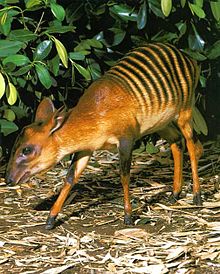Zebra duiker
| Zebra duiker | |
|---|---|
 |
|
| Scientific classification | |
| Kingdom: | Animalia |
| Phylum: | Chordata |
| Class: | Mammalia |
| Order: | Artiodactyla |
| Family: | Bovidae |
| Genus: | Cephalophus |
| Species: | C. zebra |
| Binomial name | |
|
Cephalophus zebra Gray, 1838 |
|
The zebra duiker (Cephalophus zebra) is a small antelope found primarily in Liberia, as well as the Ivory Coast, Sierra Leone, and occasionally Guinea. They are sometimes referred to as the banded duiker or striped-back duiker. It is believed to be one of the earliest duiker species to have evolved.
Zebra duiker
The scientific name of the zebra duiker is Cephalophus zebra. The bay duiker is classified under the genus Cephalophus and the family Bovidae. It was first described by British zoologist John Edward Gray in 1838 in Annals of Natural History. No subspecies are identified. The generic name probably comes from the combination of the New Latin word cephal, meaning head, and the Greek word lophos, meaning crest. The specific name zebra pertains to the striking resemblance this duiker bears to the zebra due to the presence of dorsal stripes. The word "duiker" comes from the Afrikaans word duik, or Dutch duiker - both mean "diver". The zebra duiker is locally known as the marking deer in Liberia.
...
Wikipedia

